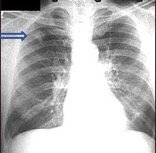There are various forms of ionizing radiation and all have the potential to cause damage. These forms differ in their impact on organic tissue. The most potent of the three types is gamma radiation. It can penetrate walls and human bodies and travels the longest distance (several metres). X-rays (which have essentially the same characteristics as gamma-rays) are used in a controlled manner by radiologists. The X-ray tube produces X-rays in order to create radiographs (Fig. 3) or do fluoroscopy. When the tube is switched off, radiation ceases to emanate from the X-ray machine. Lead-lined walls or lead aprons protect people from direct exposure to X-ray radiation during the procedure.
The radioactive isotopes of iodine I-131 or cesium Cs-137 emit gamma rays which can be detected in a patient with a whole body counter. Alpha and beta particles emit radiation over a much shorter range and alpha particles may even be blocked by a sheet of paper. However, locally they have an equally strong effect on surrounding cells. This may be the case, when these radionuclides enter the body of a living human, animal or plant. This can happen indirectly by eating for example contaminated fish or meat from animals which have grazed on contaminated pastures, such as the reindeer in Sweden following the Chernobyl accident. Strontium-90 (Sr-90) is a beta emitter and behaves in the body like calcium. It “seeks out” bone where it settles and continues to radiate locally. This radiation has the potential to create bone tumours (Fig. 4) or leukemia.
Martin Walter, MD and Andreas Nidecker, MD: « Evidence of genetic effects by ionizing radiation: greater risks at the transgenerational level », Human rights, future generations & crimes in the nuclear age, CONGRESS, 14 – 17 SEPTEMBER 2017, UNIVERSITY OF BASEL
Figure 3: Chest X-ray of a patient. The small dense area in the upper right lung (arrowed) shows a small bronchial carcinoma
